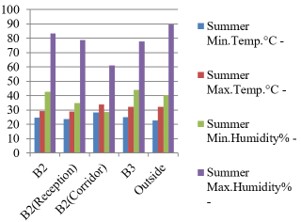Evaluation of Thermal Comfort in the Traditional Bourgeoisie Houses in Beirut
Abstract
The increasing of energy demands has considerably increased the requirements for new and traditional buildings in different climate zones. Unprecedented heat waves have increased climate temperature, in particular, in moderate climate zones such as Lebanon. In Beirut, only the residential sector consumes 50% of total electricity consumption. HVAC (Heating, Ventilation and Air conditioning) systems are used to reach acceptable thermal comfort levels in the new residential buildings. In case of the traditional bourgeoisie houses in Beirut, there are no discussions about the use of HVAC systems to achieve the required thermal comfort level. Thus, to reach an acceptable thermal comfort level, these houses which already contain natural ventilation system shall adapt the modern thermal comfort requirements and thermal comfort strategies and technologies where their architectural features and existing materials condition the available solutions. In order to identify the best options within the possible intervention lines (envelopes, passive strategies, equipment, renewable energy systems), it is necessary to perceive the real performance of this type of houses. In this context, the article presents the results of the study of thermal performance and comfort in a three case studies located in Beirut. Detailed field data records collected are analyzed, with a view to identify the indoor thermal environment with respect to outdoor thermal environment in different seasons. Monitoring also included measurement of hygrothermal parameters and surveys of occupant thermal sensation.
References
ASHRAE, A. S. C. (2005). 2005 ASHRAE Handbook - Fundamentals (SI). American Society of Heating, Refrigerating & Air Conditioning.
Houri, A., & Ibrahim-Korfali, S. (2005). Residential energy consumption patterns: The case of Lebanon. International Journal of Energy Research, 29, 755-766. https://doi.org/10.1002/er.1086
Melki, H. (2013). Windows as Environmental Modifiers in the Vernacular. In W. Weber, & S. Yannas (Eds.), Lessons from Venacular Architecture (pp. 49-118). Routledge. ISBN-13: 978-1-88407-600-0(hbk)
Parsons, K. (2014). Human Thermal Environments: The Effects of Hot, Moderate, and Cold Environments on Human Health, Comfort, and Performance (3rd ed.). Boca Raton, Florida, USA: CRC Press. ISBN 9781466595996. https://doi.org/10.1201/b16750
Republic of Lebanon 2005. (2005). Thermal Standard for Buildings in Lebanon. UNDP/GEF and MPWT/DGU.
Sehnaoui, N. (1981). L’occidentalisation de la vie quotidienne à Beyrouth: 1860 – 1914. Beirut: Dar An Nahar.
ASHRAE 90.1-2007. (2008). Energy Standard for Buildings Except Low-Rise Residential Buildings (I-P ed.). ASHRAE.
Holness, G. (2009, August). Energy Efficiency in Existing Buildings – Our Greatest Opportunity for a Sustainable Future, Sustaining Our Future by Rebuilding Our Past. ASHRAE Journal, 1, 1-4.
Issa-El-Khoury, G. (2015, March). Traditional Lebanese Houses: A Green Architecture. Building & co.(9), APAVE Liban,16-21.
Radha, C., & Kistelegdi, I. (2016, March 26-27). Efficient Natural Ventilation in Traditional and ContemporaryHouses in Hot and Dry Climate. Proceedings of 2016 International Conference on Architecture & Civil Engineering (ICAACE 2016). ISBN 978-xx-844xx-xx-x


This work is licensed under a Creative Commons Attribution 4.0 International License.
Copyright for this article is retained by the author(s), with first publication rights granted to the journal.
This is an open-access article distributed under the terms and conditions of the Creative Commons Attribution license (http://creativecommons.org/licenses/by/4.0/).








1.png)














